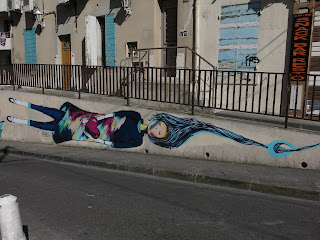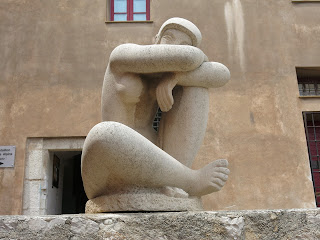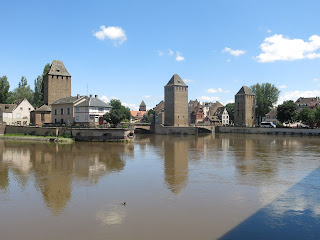I took a train east to historic
ARLES.
And while Arle's history goes back to Roman times and beyond, I was
interested in just one resident:
Vincent Van Gogh. Vincent lived and
worked here from February 1888 and May 1889 and did around 300 drawings
and paintings during that time.
 |
| Self-portrait by Vincent Van Gogh, 1887 |
First stop was the
Fondation Vincent Van Gogh Arles where they not only have a small exhibit of Van Gogh paintings, they featured a big show of
Alice Neel.
 |
| Los Angeles and There is Another Way by Rebecca Warren, 2013 and 2111 |
Calm and Exaltation is the name of the show of VVG works from the collection of Swiss industrialist Emil Buhrle. There were seven pieces shown (including the self-portrait above).
 |
| The Weeders, Saint Remy de Provence by Vincent Van Gogh, 1890 |
Alice Neel (1900-84) was known as a portrait painter with the subjects being friends, relatives and others close to her. The exhibition was quite big, I thought, but fit the atmosphere.
 |
| Jackie Curtis and Ritta Redd by Alice Neel, 1970 |
 |
| Jose by Alice Neel, 1936 |
There
is a "Circuit of Van Gogh" in Arles which identifies locations where VVG did paintings. I found a few and had a thorough tour of the old city looking for the others.
 |
| Cafe de Nuit (closed) |
Other shots from Arles:
 |
| Roman Amphitheatre, 90 A.D. |
 |
| Javier Mendez Reyes |
Between Arles and the Mediterranean Sea is a wonderful place called The Camargue. Known as the "Mouths of the Rhone," this marshy plain was designated a "Wetland of International Importance." It is also home to wild buffalo and white horses, many of which can be rented to ride on the beach.
Understandably, Van Gogh and many other artists came here to paint.
 |
| (not my shot) |
SAINTES-MARIES-DE-LA-MER is the largest town in the region and I was there for the annual Gypsy Procession for which gypsies allegedly come from the four corners of Europe to attend. On the previous day there was a procession for Sara, the patron saint of Gypsies. But the only evidence of Gypsies I saw was a small handful of wooden caravans parked next to the beach.
I got there literally just in time for the Procession of the Saints Mary Jacobe and Mary Salomer (patron saints of the town) as it proceeded through the streets, across the beach, and into the sea.
On the following day there was a demonstration of local culture at the seaside bull-fighting arena.
I had the early bus to myself on the way back to Arles, as a flock of storks passed overhead. From there I took a train to Marseilles.
As France's second city and largest port,
MARSEILLES has lots to offer, but I did not feel overwhelmed. Everything was walkable. If you like to walk. I began at the
Museum of Fine Arts.
The building was completed in 1869 with Fine Art museum on the left and Natural History on the right.
Not my usual haunt, I went there to see two murals by
Puvis de Chavannes.
 |
| Marseille-Gateway to the East by Puvis de Chavannes, 1869 |
 |
| Marseille-A Greek Colony by Puvis de Chavanes, 1869 |
Also found a couple of other pieces I liked. These are by Adolphe Monticelli and while undated, he died in 1886.
The only place to see Modern Art is the
Musee Cantini. Though the building went up in 1694, Jules Cantini, a sculptor, did not move in until 1888. He donated it to the city in 1916 and has been a museum since 1936.
The majority of Art was Contemporary:
 |
| As far as the eye can see by Lawrence Weiner, 1988 |
 |
| Il rosa de maggio by Giuseppe Caccavale, 2008-09 |
But there was a selection of Modern as well.
 |
| Monument au oiseaux by Max Ernst, 1927 |
 |
| Poichali by Victor Brauner, 1946 |
Took a boat down the coast to
L'ESTAQUE, a place once home to artists such as
Paul Cézanne, Pierre-Auguste Renoir, Raoul Dufy and Georges Braque. It was never the same after they built the arsenic factory there. Hardly a trace of what was, but the boatride was fun.
 |
| Port of Marseille |
 |
| Chateau d'If (of Count of Monte Cristo fame) |
Pictures from around Marseille.
 |
| Opera noir by Christophe Berdaguer and Marie Pejus, 2013 |
From
the Panier, the oldest part of the city.
Another train took me to
CAGNES-SUR-MER where I stayed the next week while exploring the Nice region. While CSM has extensive beaches and Art:
 |
| Le Banc de Poissons by Sylvain Subervie, 2010 |
 |
| Il n'y a plus d'obstacles by Sacha Sosno, 2007 |
It also has a center and a medieval hilltop community where
Amadeo Modigliani stayed in 1918.
As well as
Pierre Auguste Renoir's home from 1907 until his death in 1919.
CSM is located midway between Nice and Antibes, and south of ST. PAUL-DE-VENCE, home of Fondation Maeght, where I went the next day. Inaugurated in 1964, this museum was born of the friendships between Paris dealer Aime Maeght and many of the artistic luminaries of the day. The Fondation has one of the largest collections of Art in Europe, though little on display.
 |
| Les Renforts by Alexander Calder, 1963-64 |
 |
| Statue pour un jardin by Ossip Zadkine, 1965 |
 |
| Sagesse by Damien Cabanes, 2002 |
While the featured artist was A.R. Penck,
 |
| The Battlefield by A.R. Penck, 1989 |
There was other Art to see.
 |
| Jeune fille s'evadant by Joan Miro, 1968 |
 |
| Project de foulard by Alberto Giacometti, 1960 |
 |
| La Vie by Marc Chagall, 1964 |
It wasn't a long walk to the old walled city of Saint-Paul-de-Vence.
 |
| Burial place of Marc Chagall |
I had to take a bus to
VENCE. And while the museum was closed when I got there, it was a fun place to walk around. They even had a spot painted by
Chaim Soutine:
 |
| Chaim Soutine |
After lunch I walked to the
Chapelle du Rosaire du Vence where
Henri Matisse designed, during the last years of his life, what he declared to be his masterpiece. He said it took four years of exclusive energy to complete the project which, to my eye, is rather simple and plain. There was opposition from the Church and from Picasso. Photos were not allowed of the chapel, but this was legal.
The following day I took a train through Nice to
MONTE CARLO. But I found all the museums closed (between shows) and the sculpture garden inaccessible (grand prix racing the weekend before), so I had to find Art where I could.
 |
| Fraternita by Sauro Cavallini, 1999 |
 |
| La Danse des Etoiles by Christian Peschke |
 |
| Ulysses by Anna Chromy |
 |
| Sphere Enigma by Gianfranco Meggiato |
On the way back I jumped off the train early and paid a quick visit to
VILLEFRANCH-SUR-MER.


We visited
NICE a few years ago, including the
Museum of Modern and Contemporary Art and the
Musee des Beaux Arts. So it was another opportunity to walk around and see what I could find.
 |
| Loch Ness Monster by Niki de Saint-Phalle, 1992 |
 |
| Stabile Mobile by Alexander Calder, 1970 |
 |
| part of Conversation a Nice by Jaume Plensa, 2007 |
 |
| Henri Auer Patisserie Confiserie, 1820 |
 |
| Ligne indeterminee by Bernar Venet, 1984-85 |
 |
| Miles Davis by Niki de Saint Phalle, 1999 |
 |
| La Chaise by Sabine Geraudie, 2014 |
Next train to Lyon.
Once the capital of Gaul and birthplace of the emperor Claudius,
LYON is now best known as the home of Interpol and video-game designers. Then there is the
Musee des Beaux Arts. Unlike many others in France with the same name, this museum offered some Modern as well as older forms of Art.
There was sculpture:
 |
| Odalisque by James Pradier, 1841 |
 |
| La Prisonniere by Ossip Zadkine, 1943 |
More murals by
Puvis de Chavannes:
Some interesting older stuff:
 |
| Nereide, Triotn et monstre marin, Roman, 2nd century |
 |
| Les Manageurs de Ricotta by Vincenzo Campi, 1580 |
And some favorite artists:
 |
| La Barque rouge by Odilon Redon, 1905 |
 |
| Fillette aux pasteques Etude pour Le Marche au Minho by Sonia Delaunay, 1915 |
 |
| Jeune Femme en blanc, fond rouge by Henri Matisse, 1946 |
 |
| Nave nave mahana (Jour delicieux) by Paul Gauguin, 1896.JPG |
There are lots of pedestrian shopping areas in Lyon, with everything from massed street bands to bachelorettes.
 |
| L'Homme de la liberte by Cesar, 1992 |
The next day in
STRASBOURG. My apartment was practically across the street from the
Museum of Modern and Contemporary Art, so I began there. Even better, it was the first Sunday, so admission was free!
 |
| Oedipe et le Sphinx by Francois Emile Ehrmann, 1903 |
 |
| Femme nue dormant au bord de l'eau by Felix Vallotton, 1921 |
 |
| Main mysterieuse-Portrait de femme by Francis Picabia, c1938-42 |
Several unusual paintings by
Victor Brauner.
 |
| Chimere by Victor Brauner, 1939 |
 |
| La Parole by Victor Brauner, 1938 |
 |
| L'Animal moderne solidifiant l'autre temps by Victor Brauner, 1942 |
And more. None of the Contemporary was of interest.
In 1988, U.N.E.S.C.O. made the historic center a World Heritage site and it is easy to see why.
The Museum of Fine Arts is located in the old Palais Rohan. Built in the 1730s it has hosted the likes of Louis XV, Marie Antoinette, Napoleon and Josephine Bonaparte, and Charles X. Now the first two floors are filled with pictures.
 |
| Polyptyque de la Vanite et de la Redemption by Hans Memling, c 1490 |
 |
| Venus et l'Amour by anon |
 |
| La Vierge consolatrice by William Bouguereau, 1877 |
 |
| Jeanne d'Arc embrassant l'epee de la Delivrance by Dante Rossetti, 1863 |
One more train took me across the German border into
STUTTGART. Located in the fertile Neckar valley, the city is home to Mercedes, Porsche, Bosch, and Daimler. They also have Art museums.
I began with the
Kunstemuseum also known as "The Cube." Out front is this Calder.
 |
| Crinkly avec disque rouge by Alexander Calder, 1973 |
Inside was Contemporary art.
 |
| by Josef Albers |
 |
| PYR 522 by Hans Jorg Glattfelder, 1939 |
And Otto Dix.
 |
| Drei Weiber by Otto Dix, 1926 |
The more you walk, the more sculpture you find.
 |
| Lobochevsky by Mark di Suvero, 1988 |
 |
| Frauenbuste by Jurgen Goertz, 1993 |
 |
| Denkpartner by Hans-Jorg Limbach, 1980 |
There were multiple obstacles, but I finally found
Staatsgalerie Stuttgart. Originally opened in 1843, there is Art from all periods to see.
 |
| Two Girls in the Reeds by Otto Mueller, c 1920 |
 |
| Striding into the Sea by Ernst Ludwig Kirchner, 1912 |
 |
| The Prophet by Egon Schiele, 1911 |
 |
| Nude Girl on a Red Cloth by Edvard Munch, 1902 |
 |
| Female Nude Reclining on a White Pillow by Amedeo Modigliani, c 1917 |
I took an airplane to BERLIN for my next stop. I was there on the invitation of a couple I met in Crete. It was my plan to visit the new Barberini Museum in nearby Potsdam, but discovered the inaugural show was down and there was nothing to see. And we had seen most of the art museums in the city on a previous trip. One new one was the Berlinische Galerie. Housed in a former glass warehouse, the collections include many Secessionist painters, but there was mostly photos and contemporary pieces on display. There was noticeably more woman artists being shown here than usual.
 |
| Flute Player by Julie Wolfthorn, c 1900 |
 |
| Landscape, Painting I by Jacoba van Heemskerck, c 1914 |
 |
| Self-portrait in Front of Friedrichsruher Strasse by Lotte Laserstein, c 1928 |
 |
| Die Journalisten by Hannah Hoch, 1925 |
Music Hall Girls & Valeska Gert by Jeanne Mammen, 1928-29
I was taken on a bicycle tour of Berlin, which was great but didn't get all the pictures I would have liked.
We stopped at the
Museum Berggruen in the Charlottenburg neighborhood. I had been here before, but appreciated the revisit. I learned that Berggruen was a long-time collector and dealer who at one point decided to get rid of everything and just concentrate of four artists: Picasso, Matisse, Alberto Giacometti and Paul Klee.
 |
| Silenus in Dancing Company by Pablo Picasso, 1933 |
 |
| Blue Nude Skipping by Henri Matisse, 1952 |
 |
| Red Girl with Yellow Bowl-Shaped Hat by Paul Klee, 1919 |
They had work by other artists, as well.
 |
| The Acrobat by Marc Chagall, 1967 |
 |
| Young Woman with her Hair Unfastened by Paul Cezanne, c 1873-74 |
 |
| Small Mobile by Alexander Calder |
Other shots from around the city:
 |
| Dreiheit by Brigitte and Martin Matschinsky-Denninghoff, 1993 |
 |
| Berlin's largest mural, 2009 |
Two sections of the Berlin Wall.
Time for a train west to
MUNSTER for the
5th Skulptur Projekte Münster. While only the fifth incarnation, exhibitions began here in 1977 and are held every ten years. Past luminaries have included
Claes Oldenburg,
Henry Moore,
Eduardo Chillida, and
Richard Serra.
 |
| Large Vertebrae by Henry Moore, 1968-69 |
 |
| Giant Pool Balls by Claes Oldenburg, 1977 |
I found later that the curators for this year's offering purposely emphasized other media than traditional sculpture. Things like performance, audio, video, photographs, other 2D. Though there was occasional 3D.
 |
| untitled by Sany, 2017 |
 |
| HellYeahWeFuckDie by Hito Steyeri, 2016 |
 |
| A Work in Situ by John Knight, 2017 |
 |
| Nietzsche's Rock by Justin Matherly, 2017 |
After I tired of searching, I went inside to see what the LWL-Museum fur Kunst und Kultur had to offer. I found artworks from old religious stuff to contemporary, with some Modern in between. Problem was, the security man in the Modern section thought my camera's aiming light was a flash and made me stop taking pictures. I got a few before the incident.
 |
| Adam and Eve by Lucas Cranach the Elder, 1525 |
 |
| Self-portrait with white Pearl Necklace by Paula Modersohn-Becker, 1906 |
 |
| Dunes in the Evening by Lyonel Feininger, 1927 |
Time for my last stop,
GRONINGEN, Nederland. The largest city in northern Nederland, it is also a university town with everything you expect from a Dutch city.
 |
| Ultra by Sylvia B., 2005 |
 |
| Traffic by Willem Reijers, 1959 |
 |
| Het Peerd van Ome Loeks by Jan de Baat, 1959 |

 |
| grocery store |
The Groninger Museum featured a whimsical building filled with a variety of Art. From old stuff:
 |
| Rudolf Agricola by Lucas Cranach the Elder, 1443-1485 |
 |
| The Garden of the Vicarage in Nuenen in spring by Vincent Van Gogh, 1884 |
To newer things:
 |
| Madonna 6 by Christie van der Haak, 1984 |
 |
| Christ and the Lamb by Jeff Koons, 1988 |
But the biggest display was for the artists of
De Ploegg (The Plow). Founded in 1918 by several young artists in order to facilitate exhibitions, several Modern styles were evident. When an ill
Jan Wiegers went to Davos, Switzerland for a cure, he met leading German Expressionist,
Ernst Ludwig Kirchner. He shared what he had learned with his fellow artists.
 |
| Jan Wiegers by Johan Dijkstra, c 1927 |
 |
| Johan Dijkstra by Jan Wiegers, c 1926 |
 |
| Seated Nude by Jan Wiegers, 1925 |
 |
| Girl with Child by Ernst Ludwig Kirchner, 1919 |
A few last shots.
 |
| 10 Foal by Wladimir de Vries, 1951 |
 |
| Dirty Beak by Hans Mes, 1984 |
 |
| All-Women road race |
And that's the end. Ten weeks of Art.

























































































































































































































1 comment:
As usual great photos Rusty! enjoyed them!
Post a Comment